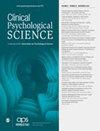青少年精神病理学症状层次结构的层次模型
IF 4.1
2区 医学
Q1 PSYCHIATRY
引用次数: 0
摘要
我们需要对青少年的精神病理学进行更全面的建模,以促进精神病理学层次分类法(HiTOP)模型在发展过程中的扩展。在这项研究中,我们研究了一个儿童和青少年精神病理学结构的症状层面模型,该模型的年龄大多在 11 至 17 岁之间,我们将来自大型临床、社区和代表性样本(N = 18,290 )的数据整合在一起,涵盖了几乎所有主要形式的精神障碍和相关内容领域(如攻击性)。由此产生的分层和维度模型以三种统计方法的汇合点为基础,包括 15 个狭义维度,嵌套在 (a) 内化、(b) 外化、(c) 饮食病理学和 (d) 无法控制的担忧、强迫症和强迫症四个广义维度之下。我们将这些发现置于现有文献的背景下,并阐明了对未来研究的影响。最终,这些发现为迅速增长的有关青少年精神病理学结构的文献增添了新的内容,并朝着量化精神病理学结构在整个生命周期的(不)连续性迈进了一步。本文章由计算机程序翻译,如有差异,请以英文原文为准。
A Hierarchical Model of the Symptom-Level Structure of Psychopathology in Youth
More comprehensive modeling of psychopathology in youth is needed to facilitate a developmentally informed expansion of the Hierarchical Taxonomy of Psychopathology (HiTOP) model. In this study, we examined a symptom-level model of the structure of psychopathology in children and adolescents—most aged 11 to 17 years—bringing together data from large clinical, community, and representative samples ( N = 18,290) covering nearly all major forms of mental disorders and related content domains (e.g., aggression). The resulting hierarchical and dimensional model was based on the points of convergence among three statistical approaches and included 15 narrow dimensions nested under four broad dimensions of (a) internalizing, (b) externalizing, (c) eating pathology, and (d) uncontrollable worry, obsessions, and compulsions. We position these findings within the context of the existing literature and articulate implications for future research. Ultimately, these findings add to the rapidly growing literature on the structure of psychopathology in youth and move a step closer toward quantifying (dis)continuities in psychopathology’s structure across the life span.
求助全文
通过发布文献求助,成功后即可免费获取论文全文。
去求助
来源期刊

Clinical Psychological Science
Psychology-Clinical Psychology
CiteScore
9.70
自引率
2.10%
发文量
35
期刊介绍:
The Association for Psychological Science’s journal, Clinical Psychological Science, emerges from this confluence to provide readers with the best, most innovative research in clinical psychological science, giving researchers of all stripes a home for their work and a place in which to communicate with a broad audience of both clinical and other scientists.
 求助内容:
求助内容: 应助结果提醒方式:
应助结果提醒方式:


